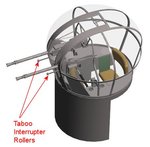- Thread starter
- #21
seesul
Senior Master Sergeant
Hi Terry,
here´s the promised information about antenna on a B-17G posted by Jim Peters, a former B-17G flight engineer, serving in 99th BG:
...a small correction....there were TWO wires attached to the vertical fin...the one on the left was the Liaison Antenna, that connected to an antenna standoff around the left radio room window and then to the large (approx 4 ft x 4ft x 18 inchs or so),Liaison box, on the back left wall of the radio room and connected to a large knife switch just forward of the Liaiason Box...the knife switch, switched between the left long antenna,and a whip antenna on the bottom of the fuselage. (The early B-17s used a small wire across the walkway, and nearly decapitated anyone sliding off the walkways on both sides of the trailing edge of the wing, and was changed to the whip antenna under the fuselage).
The B-17G that is out on summer tour with the Arizona Wing CAF, has the Large Liaison Box with the large knife switch installed, with the proper long wires on both sides of the vertical fin.
The right long antenna wire connected via an antenna standoff,on the right side of the radio room,by the right radio room window, to the Command Radios located just to the right of the radio room door into the bombay.
Most artists in drawing the B-17, usually connect one wire to the radio room and the other terminates at the "Axe Handle" antenna, where no B-17 I ever flew on was connected to the "Axe Handle" antenna. The "Axe Handle" was an A/N, which means that it was used on many smaller aircraft of both the USAF and Navy and Marine aircraft as well.
The so called "Axe Handle' Antenna was for the marker antenna, and was NOT connected to the long wires attached to the vertical fin. (Reference 1B-17G-4, Illustrated Parts Breakdown).
Jim
here´s the promised information about antenna on a B-17G posted by Jim Peters, a former B-17G flight engineer, serving in 99th BG:
...a small correction....there were TWO wires attached to the vertical fin...the one on the left was the Liaison Antenna, that connected to an antenna standoff around the left radio room window and then to the large (approx 4 ft x 4ft x 18 inchs or so),Liaison box, on the back left wall of the radio room and connected to a large knife switch just forward of the Liaiason Box...the knife switch, switched between the left long antenna,and a whip antenna on the bottom of the fuselage. (The early B-17s used a small wire across the walkway, and nearly decapitated anyone sliding off the walkways on both sides of the trailing edge of the wing, and was changed to the whip antenna under the fuselage).
The B-17G that is out on summer tour with the Arizona Wing CAF, has the Large Liaison Box with the large knife switch installed, with the proper long wires on both sides of the vertical fin.
The right long antenna wire connected via an antenna standoff,on the right side of the radio room,by the right radio room window, to the Command Radios located just to the right of the radio room door into the bombay.
Most artists in drawing the B-17, usually connect one wire to the radio room and the other terminates at the "Axe Handle" antenna, where no B-17 I ever flew on was connected to the "Axe Handle" antenna. The "Axe Handle" was an A/N, which means that it was used on many smaller aircraft of both the USAF and Navy and Marine aircraft as well.
The so called "Axe Handle' Antenna was for the marker antenna, and was NOT connected to the long wires attached to the vertical fin. (Reference 1B-17G-4, Illustrated Parts Breakdown).
Jim



